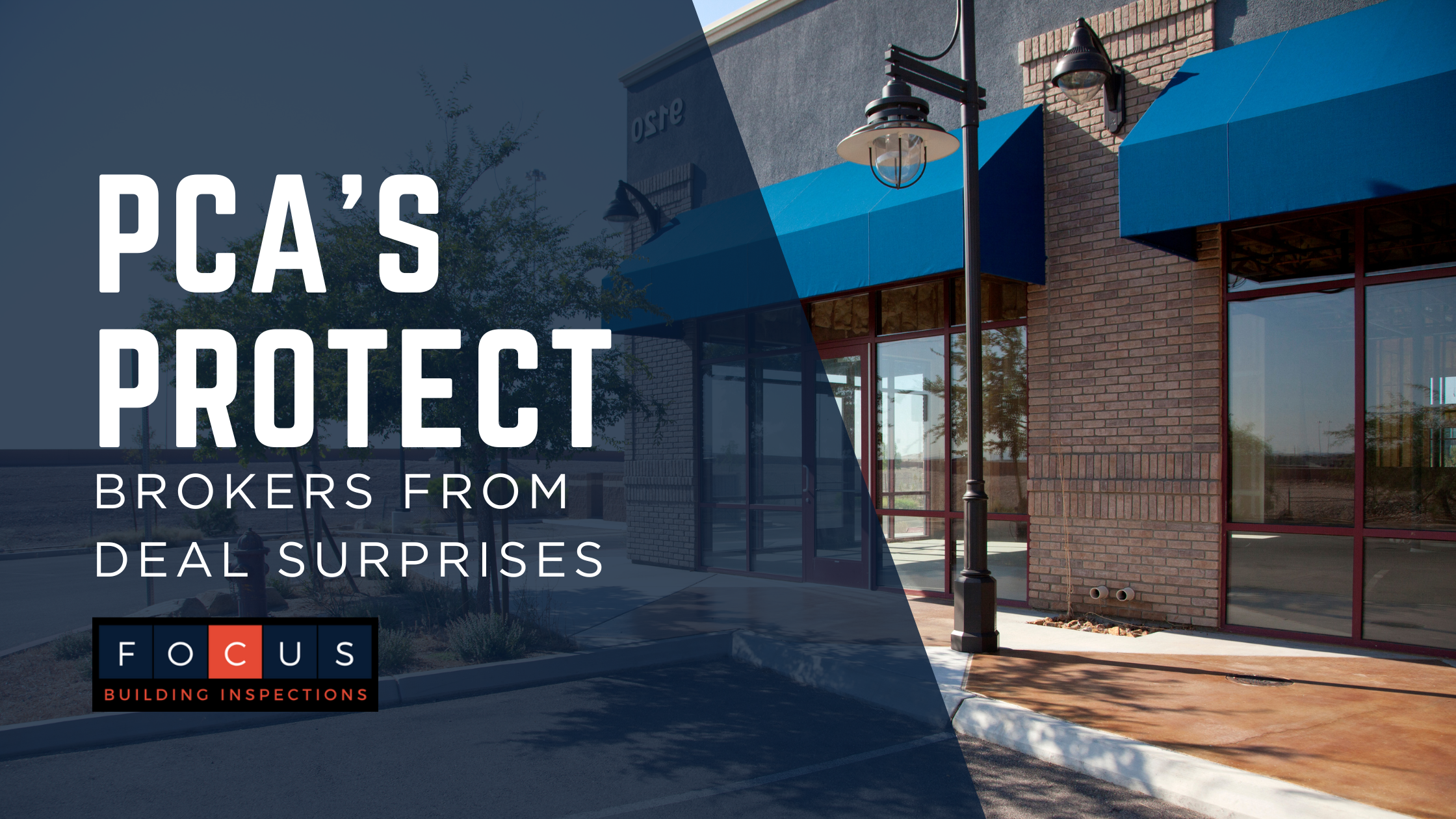How PCAs Protect Brokers from Deal Surprises
Introduction: Why Brokers Can’t Afford Surprises in Commercial Deals
Commercial real estate brokers thrive on closing deals efficiently and profitably. Yet, the path from offer to closing can be riddled with unexpected issues that derail timelines, strain negotiations, or jeopardize commissions. One of the most common culprits? Hidden building defects or long-term maintenance liabilities that weren’t uncovered until late in the due diligence process.
This is where a Property Condition Assessment (PCA), performed according to ASTM E2018 standards and CCPIA guidance, becomes an invaluable tool for brokers. Far from being just a technical report, a PCA empowers brokers to anticipate risks, maintain credibility with clients, and protect deals from collapsing due to unforeseen property issues.
How PCAs Protect Brokers from Deal Surprises
What is a Property Condition Assessment (PCA)?
A PCA is a comprehensive inspection of a commercial building’s physical condition. According to ASTM E2018, the recognized industry standard, a PCA evaluates major building systems—including structure, roof, mechanical systems, plumbing, electrical, and site improvements—and identifies both immediate repair needs and projected costs over a 10-year horizon.
When bundled with an Accessibility (ADA) Inspection and a Cost-to-Cure Report, a PCA gives brokers and their clients a full-spectrum view of the property’s condition and compliance profile.
Why Brokers Should Recommend a PCA Early
Brokers play a pivotal role in setting client expectations during acquisition. A PCA allows brokers to:
Identify deal-killers early – Major defects (e.g., failing HVAC systems, roofing near the end of service life, structural cracks) can derail a transaction if discovered late.
Negotiate with confidence – Cost-to-cure projections provide leverage in pricing discussions or repair concessions.
Protect client trust – Recommending a PCA demonstrates professionalism, transparency, and commitment to protecting the client’s investment.
Close faster – Surprises late in due diligence often mean renegotiation or delays. A PCA moves those discoveries earlier in the process.
Real-World Example: Roof Replacement Costs
Consider a broker representing a buyer for a 50,000-square-foot industrial building. Midway through negotiations, the buyer learns the roof membrane is at the end of its service life. Replacement estimates climb into the six figures, catching both broker and client off guard.
Had a PCA been conducted earlier, the roof’s condition and replacement costs would have been flagged immediately. The broker could have:
Advised the client to negotiate a seller credit.
Adjusted the offering price upfront.
Demonstrated foresight and protected client trust.
Instead of scrambling, the broker would be seen as proactive and value-driven.
Key Components of a PCA That Matter to Brokers
1. Immediate Repairs
ASTM E2018 requires identification of “immediate” repair needs—safety hazards, code violations, or items critical to building operations. For brokers, this helps clarify whether a property is realistically financeable or insurable.
2. Short-Term Costs (0–2 Years)
Items that will require repair or replacement soon—such as HVAC units past their expected service life—can dramatically affect net operating income projections.
3. Long-Term Costs (2–10 Years)
A PCA provides a 10-year cost-to-cure projection, helping brokers frame realistic ownership costs for clients and avoid underestimating capital expenditures.
4. Accessibility (ADA) Compliance
Churches, schools, and retail brokers face heightened risks around ADA accessibility. Non-compliance may limit tenant usability, pose liability concerns, or even stall lease approvals. Bundling an ADA inspection with a PCA gives brokers leverage in lease negotiations and protects clients from potential lawsuits.
Broker-Specific Benefits of PCAs
For Commercial Real Estate Brokers
Protect reputation – Nothing undermines trust faster than overlooked building issues.
Enhance advisory role – By bringing a PCA into the conversation, brokers elevate their position from transaction facilitator to trusted advisor.
Win repeat business – Clients who feel protected by their broker are more likely to return for future deals.
For Lenders Working with Brokers
Lenders often rely on PCA findings to evaluate loan risk. Brokers who anticipate lender requirements streamline financing approvals and reduce friction at closing.
For Investors and REITs
Portfolio buyers need to understand not just one building but portfolio-wide exposure to deferred maintenance. A PCA offers scalable insight into capital planning, which brokers can use to pitch investment strategies.
For Churches and Schools
Faith-based and educational institutions often lack in-house facilities expertise. Representatives of these clients can distinguish themselves by ensuring long-term maintenance liabilities are visible before contractors are hired.
Avoiding the “Surprise Factor”: Common Issues Found in PCAs
According to industry guidance from CCPIA and ASTM, the following building issues frequently surface during PCAs:
Roofs nearing end-of-life (often a 20–25 year replacement cycle).
Aging mechanical systems (HVAC systems past 15–20 years).
Deferred maintenance on parking lots, facades, and landscaping.
ADA non-compliance in restrooms, ramps, or entrances.
Water intrusion issues leading to mold or structural concerns.
For brokers, knowing these common red flags allows proactive discussions with buyers and sellers—before they become surprises.
Integrating PCAs into the Broker Workflow
During Listing Preparation
Encourage sellers to commission a PCA before listing. This allows brokers to market properties with transparency, reducing the risk of renegotiations.At Buyer Engagement
Recommend PCAs as part of the buyer’s due diligence package, framing it as a safeguard against financial surprises.In Financing Conversations
Position PCA findings as tools for smoother lender approval, particularly when Cost-to-Cure projections are available.
Practical Takeaway for Brokers
Commercial real estate transactions thrive on certainty and trust. By recommending Property Condition Assessments (PCAs), brokers safeguard clients from deal-killing surprises, elevate their advisory role, and protect their reputation in a competitive marketplace.
The next time you prepare to market or represent a commercial property, ask yourself:
Have I given my client every tool they need to avoid a bad surprise?
A PCA might be the single most important answer.
Bibliography:
ASTM International. (2018). ASTM E2018-15: Standard Guide for Property Condition Assessments: Baseline Property Condition Assessment Process. ASTM International. https://www.astm.org/e2018-15.html
Certified Commercial Property Inspectors Association (CCPIA). (n.d.). Commercial Property Inspection Resources.CCPIA. https://ccpia.org
Keywords:
Property Condition Assessment (PCA)
ASTM E2018 commercial inspections
Commercial building inspection for brokers
Cost-to-cure reports commercial real estate
ADA compliance inspection commercial property
Capital expenditure planning brokers
CCPIA commercial inspection guidance
CRE due diligence inspections
PCA for brokers lenders investors
Commercial inspection Tulsa (insert local keyword as needed)


